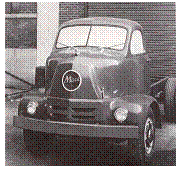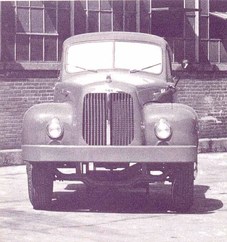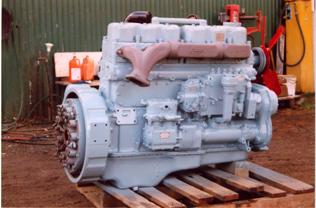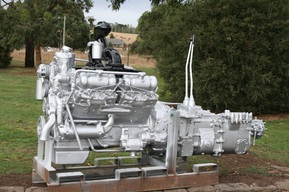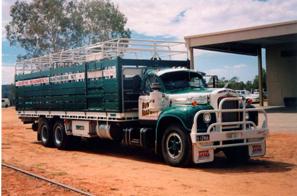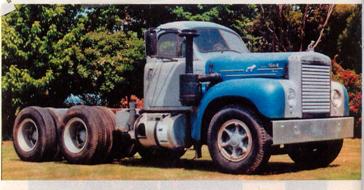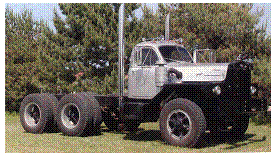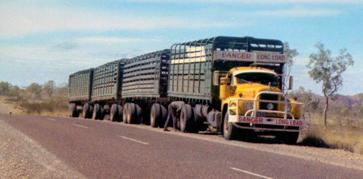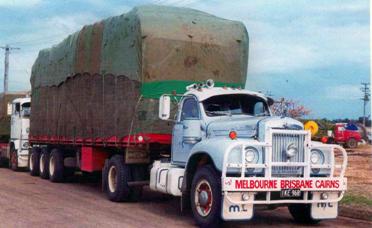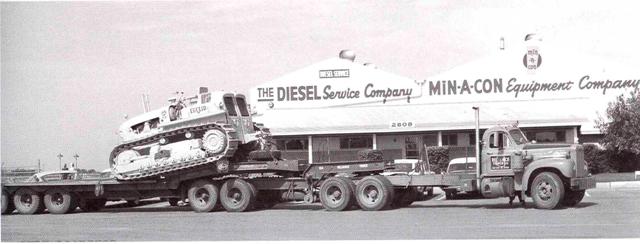If you dream it, we'll make it!
|
1906 Trentham Road
KYNETON 3444 VIC AUSTRALIA |
THE MACK B MODEL TRUCK
BY IAN LEE
The all new B Model was introduced in the US in the spring of 1953 and quickly became a timeless part of our transport history and has become the most widely admired collector truck in Australia with 11 making it to the “Transport Hall of Fame” in Alice Springs in 2000 and 36 in 2005, and hopefully many more than 60 in 2010.
I was to see my first B Model on a trip to Brisbane in April 1957, it was parked on the side of the road and it left a lasting impression. The truck belonged to ‘Fosters’ a trucking firm from Toowoomba, and I understand one of the first to reach Australia.
There were 127,000 B Models built from 1953 to 28 April 1966, and available in 68 different models.
I was to see my first B Model on a trip to Brisbane in April 1957, it was parked on the side of the road and it left a lasting impression. The truck belonged to ‘Fosters’ a trucking firm from Toowoomba, and I understand one of the first to reach Australia.
There were 127,000 B Models built from 1953 to 28 April 1966, and available in 68 different models.
|
The “B” Model development started in the mid 1940’s with the prototype “M8” with a split windscreen to reduce drive glare and a new graceful rounded cabin. Note: the similarity of the bonnet with the earlier AC. Another interesting feature is it had a round shaped dog mascot and different to the one on the production model to the one on the production model. |
The all new “B” series would prove to be a complete departure from conventional trucks of the period. The blunt new front with headlights built into the mudguard spaces giving them a timeless beauty, distinguishing them from all other trucks of the period, which had bug eye headlights poking out of the mudguard.
A proud long eared dog standing on top of the grill and generous use of chrome on both sides. Service was improved with snap on sections in the mudguards.
The first two models, the B20 – 1700lbs (7.7 tonnes), GVM and the B42 with up to 60,000lbs (27 tonnes) GCW, with 10 more models by the end of 1953. Cabins were built at the 5C plant at Allentown PA. The door lock fittings were supplied by Briggs and Stratton.
Power and starting were improved with the new range of diesel engines with direct injection and the engine used the synchrorance automatic injection timing and a departure from the Lanova pre-combustion engine which had been used by Macks since 1938.
A proud long eared dog standing on top of the grill and generous use of chrome on both sides. Service was improved with snap on sections in the mudguards.
The first two models, the B20 – 1700lbs (7.7 tonnes), GVM and the B42 with up to 60,000lbs (27 tonnes) GCW, with 10 more models by the end of 1953. Cabins were built at the 5C plant at Allentown PA. The door lock fittings were supplied by Briggs and Stratton.
Power and starting were improved with the new range of diesel engines with direct injection and the engine used the synchrorance automatic injection timing and a departure from the Lanova pre-combustion engine which had been used by Macks since 1938.
A limited number of petrol “B” Models reached Australia, I do remember seeing a new petrol model on an agents show room floor in Perth, at least 10 models were Cummins powered the largest being a NTC 335. Only a limited number of Cummins B Models reached our shores and it would seem most went to Western Australia.
Gearing The concept of two lever gear boxes was not new, but Mack improved this with its new quadruplex with the two boxes built as one unit including the new TRQ 7210 overgear with 5 in the main box and 4 in the compound giving 18 useable gears. This concept allowed good road speeds and low series of ratios for heavy pulls and 4 reverse gears.
There was available a 10 speed 2 lever duplex, a 13 speed triplex and in the USA a 10 speed single lever unishift.
Optional extras were auxiliary 3 speed gear box which was available, this was built by Spicer and operated separately to main and compound box giving the driver 3 gear box levers in the cabin.
Mack pioneered the use of automatic gearboxes in fire trucks in this period, first with a torque convertor in 1956 and fully automatic in 1957.
Gearing The concept of two lever gear boxes was not new, but Mack improved this with its new quadruplex with the two boxes built as one unit including the new TRQ 7210 overgear with 5 in the main box and 4 in the compound giving 18 useable gears. This concept allowed good road speeds and low series of ratios for heavy pulls and 4 reverse gears.
There was available a 10 speed 2 lever duplex, a 13 speed triplex and in the USA a 10 speed single lever unishift.
Optional extras were auxiliary 3 speed gear box which was available, this was built by Spicer and operated separately to main and compound box giving the driver 3 gear box levers in the cabin.
Mack pioneered the use of automatic gearboxes in fire trucks in this period, first with a torque convertor in 1956 and fully automatic in 1957.
Rear Drives
Drive Axle Single drive RAS 507 with ratios from 4.62 & 5.78 to 6.83 was a common on highway model.
Most bogey axles used on heavy work were the SWD 571, 40,000lb rating with CRDP 92/93 carrier (centres) with 50 and 55 inch axle centres with Mack power divider camel back leaf springs.
A light weight bogey was available for highway work, the SWDL56, 34,000lb rating again with 50 and 55” axle centres the carriers were the same rating on light and heavy weight options. Only the axle housing, spring pivot point and axles changed.
Common ratios from 4.5 – 5.13, 5.73 – 6.34, 7.00 – 7.49, 8.24 – 9.15, 10.57 – 11.80.
Large numbers of Australian spec B models had double overdrive gear boxes, so the lower ratio diffs were the general. The one used in the spec sheet enclosed used 7.49, this would have given a top road speed of say 80Km per hour, the 6.34 mid 90Km per hour.
Legal road speed varied for each state with South Australia the lowest at 25 mph highway speed.
Front Axle Two models most common in Australia was the FA505 and came with chrome hubcaps, its capacity was 9000lbs or 4 US tonnes, or the heavier option FA517 which had flat pressed in centres held on with bolts, its capacity 9500lbs or 4.75 US tonnes, a heavier domed cap was also bolted and was FA 600 capacity 16,000lbs or 8 US tonnes, the B81 SX had this axle.
Springs were improved, Vari-rate to improve ride, both loaded and empty. The spring ends were clamped between rubber cushions and proved ideal on our poor roads. Most Australian “B” Models had the optional 10hp air starters, this was to prove an asset on rough roads where batteries were often shook to pieces. Many outback operators carried hoses to use air from the tyres if low on starting air.
World sales of Mack trucks doubled between 1954 to 1956, the new “B” Series range kept increasing with models for city delivery, long distance haulage and a major part of Mack sales was in construction with single, tandem drive, all wheel drive and the B80 super duty truck with dual reduction in both four and six wheel drive.
Drive Axle Single drive RAS 507 with ratios from 4.62 & 5.78 to 6.83 was a common on highway model.
Most bogey axles used on heavy work were the SWD 571, 40,000lb rating with CRDP 92/93 carrier (centres) with 50 and 55 inch axle centres with Mack power divider camel back leaf springs.
A light weight bogey was available for highway work, the SWDL56, 34,000lb rating again with 50 and 55” axle centres the carriers were the same rating on light and heavy weight options. Only the axle housing, spring pivot point and axles changed.
Common ratios from 4.5 – 5.13, 5.73 – 6.34, 7.00 – 7.49, 8.24 – 9.15, 10.57 – 11.80.
Large numbers of Australian spec B models had double overdrive gear boxes, so the lower ratio diffs were the general. The one used in the spec sheet enclosed used 7.49, this would have given a top road speed of say 80Km per hour, the 6.34 mid 90Km per hour.
Legal road speed varied for each state with South Australia the lowest at 25 mph highway speed.
Front Axle Two models most common in Australia was the FA505 and came with chrome hubcaps, its capacity was 9000lbs or 4 US tonnes, or the heavier option FA517 which had flat pressed in centres held on with bolts, its capacity 9500lbs or 4.75 US tonnes, a heavier domed cap was also bolted and was FA 600 capacity 16,000lbs or 8 US tonnes, the B81 SX had this axle.
Springs were improved, Vari-rate to improve ride, both loaded and empty. The spring ends were clamped between rubber cushions and proved ideal on our poor roads. Most Australian “B” Models had the optional 10hp air starters, this was to prove an asset on rough roads where batteries were often shook to pieces. Many outback operators carried hoses to use air from the tyres if low on starting air.
World sales of Mack trucks doubled between 1954 to 1956, the new “B” Series range kept increasing with models for city delivery, long distance haulage and a major part of Mack sales was in construction with single, tandem drive, all wheel drive and the B80 super duty truck with dual reduction in both four and six wheel drive.
|
1955 saw the B73 and B75 highway truck series designed to replace the LTL for the US West Coast market, available with the optional larger L cabin for the driver who required more space. The photo shows the standard B cabin, these models were not used in Australia but recently some have been bought into the country. The bonnet is much longer, there is more leg room and improved steering wheel angle. Photo shows an imported B75. |
Transport in the 1950’s in Australia was strongly opposed by State and Federal Governments who had over borrowed and extended their poor service on railway systems to areas where there was little revenue and from the 1920’s had progressively bought in laws to stop road transport competing with the Railways.
An example: because of the two railway gauges between Melbourne and Sydney the freight had to be transferred at Albury to each states rail wagons, meaning each item was handled six or more times, this was to continue up until the 1960’s.
Each state had its own set of rules governing road transport and it was difficult to get permits beyond 25 miles (40 km) from a truck operators depot, this meant trucks were generally small and most heavy trucks were working where rail had not extended to.
The legality of these laws had been challenged in the courts on more than one occasion.
In 1954 a group of carriers in the eastern states pooled their resources for another challenge. The plaintiff they chose was a small Sydney based firm of Hughes and Vale, their legal team argued that the New South Wales Government system of fees and permits on interstate trade infringed Section 92 of the Commonwealth Constitution which guaranteed freedom of trade between the states.
The case went all the way to the Privy Council in London in late 1954, the court ruled in favour of the carriers.
The states were to change the laws to get around the Privy Council judgement and again in 1955 the High Court ruled in favour of the road carriers.
The Hughes and Vale victory opened up interstate road freight with door to door service, goods were now delivered in days as against weeks by rail. State carriers started up a system on this ruling also where they crossed the border, then carried the goods back into the state it came from. This often involved 100’s of extra kilometer.
It was the 1980’s before the states allowed road transport to compete with the railways. Carriers offered overnight door to door service. Overnight railway goods services stopped being used. No longer did the farmer walk his livestock to the railway loading yards, he too had door to door service.
This ruling in 1955 happened about the time the B Model became available in numbers and the expansion of our transport system helped our nation expand.
An example: because of the two railway gauges between Melbourne and Sydney the freight had to be transferred at Albury to each states rail wagons, meaning each item was handled six or more times, this was to continue up until the 1960’s.
Each state had its own set of rules governing road transport and it was difficult to get permits beyond 25 miles (40 km) from a truck operators depot, this meant trucks were generally small and most heavy trucks were working where rail had not extended to.
The legality of these laws had been challenged in the courts on more than one occasion.
In 1954 a group of carriers in the eastern states pooled their resources for another challenge. The plaintiff they chose was a small Sydney based firm of Hughes and Vale, their legal team argued that the New South Wales Government system of fees and permits on interstate trade infringed Section 92 of the Commonwealth Constitution which guaranteed freedom of trade between the states.
The case went all the way to the Privy Council in London in late 1954, the court ruled in favour of the carriers.
The states were to change the laws to get around the Privy Council judgement and again in 1955 the High Court ruled in favour of the road carriers.
The Hughes and Vale victory opened up interstate road freight with door to door service, goods were now delivered in days as against weeks by rail. State carriers started up a system on this ruling also where they crossed the border, then carried the goods back into the state it came from. This often involved 100’s of extra kilometer.
It was the 1980’s before the states allowed road transport to compete with the railways. Carriers offered overnight door to door service. Overnight railway goods services stopped being used. No longer did the farmer walk his livestock to the railway loading yards, he too had door to door service.
This ruling in 1955 happened about the time the B Model became available in numbers and the expansion of our transport system helped our nation expand.
One company who was quick to place the B Model in their fleet was Western Transport and part of their fleet was familiar site at the Brisbane Transport Terminal at Rocklea. The terminal was owned by Western, they also were the Mack agents since 1953 for Queensland. I can remember watching the trucks being assembled in an open unsealed yard in front of an old shed at the rear of the terminal. They were sent out in large wooden boxes partly dismantled, two trucks in three crates (see build sheet of a B Model specifications of a Western built truck on page 10).
The terminal was on a large open area with few other buildings, there was a service station, Chinese café, driver accommodation, transport offices with some old sheds at the rear of the site. There was a lot of black dust in the summer and some kind of a tip at the rear.
The new model quickly built a strong identity with the public and customers alike and was to play a major part in opening up the remote regions of Australia and quickly proved it had the gearing, power and stamina to pull multiple trailers across the heavy unmade black soil plains of Queensland to the vast outback cattle stations, and further west following the tracks left by the cattle, which up until then had only walked to market.
The terminal was on a large open area with few other buildings, there was a service station, Chinese café, driver accommodation, transport offices with some old sheds at the rear of the site. There was a lot of black dust in the summer and some kind of a tip at the rear.
The new model quickly built a strong identity with the public and customers alike and was to play a major part in opening up the remote regions of Australia and quickly proved it had the gearing, power and stamina to pull multiple trailers across the heavy unmade black soil plains of Queensland to the vast outback cattle stations, and further west following the tracks left by the cattle, which up until then had only walked to market.
Heavy haulage stories quickly spread of extensive over loading up over the worst of steep mountains, often stopping to help other trucks not up to the task.
They quickly proved the manufacturers claim of its unique engineering and high resale value.
They quickly proved the manufacturers claim of its unique engineering and high resale value.
Another story I remember is of overloaded “B” Models being impounded by the law and three semis were required to take the surplus freight to allow the “B” Model to continue! (Note: In the 60’s the law allowed 26 tons gross on two tandem axles and 8 tons on single axles, so many semis had only a legal payload of 10 to 11 tons).
Today it seems hard to imagine, a truck with only 211hp and lots of gears would seem to other drivers quite awesome, but then they may have had only 120hp and would lose half their road speed before any serious climbing began.
Today it seems hard to imagine, a truck with only 211hp and lots of gears would seem to other drivers quite awesome, but then they may have had only 120hp and would lose half their road speed before any serious climbing began.
B Mack moving a Euclid TC12 twin engine dozer shown without the blade.
I operated one of these machines for a short period (Note: this photo is from USA)
I operated one of these machines for a short period (Note: this photo is from USA)
|
Lee No.3 Pty Ltd
Trading since 1961 ACN: 005 204 599 ABN: 40 005 204 599 |
For more information please contact Ian Lee on 0428 507 408 [email protected] |
PO Box 614
KYNETON 3444 VICTORIA, AUSTRALIA |
